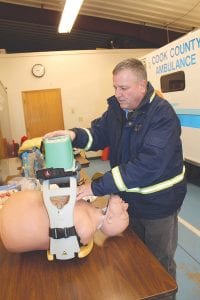Cook County North Shore Hospital Ambulance Director Steve DuChien demonstrates how the LUCAS automated chest compression device works. The device, which the hospital received because of a grant from the Leona M. and Harry B. Helmsley Charitable Trust, allows emergency workers to give uninterrupted CPR while attending to a patient’s other needs. DuChien said the machine could be a lifesaver.

Cook County Ambulance Director Steve DuChien was pleased to give a demonstration recently of a new piece of life-saving equipment on board the ambulance and at the hospital, the Physio- Control LUCAS® 2 Chest Compression System. The automated chest compression device will allow emergency workers to give uninterrupted CPR while attending to a patient’s other needs.
Fortunately the ambulance service or hospital have not needed to use the device, but DuChien explained that in theory medical personnel can have the LUCAS on a patient in 25 seconds or less. It has worked well in practice sessions, said DuChien.
During the initial training for all ambulance crew members and hospital personnel, the LUCAS instructor had emergency personnel go through several cycles of CPR on the practice manikin. DuChien said the device not only provides the appropriate amount of pressure to reestablish heart rhythm during cardiac arrest, it stops and lets responders know when it is time for rescue breathing. “The beauty of it is, it stops. It lets us know it’s time for a breath,” said DuChien. “It keeps people from making mistakes.”
The device also eliminates rescuer fatigue. DuChien said there have been ambulance trips to Duluth when it was necessary to perform CPR the entire way. “It’s just not effective,” he said.
The grant for the Physio-Control LUCAS® 2 Chest Compression System came from the Minnesota Department of Health on behalf of the Leona M. and Harry B. Helmsley Charitable Trust. The grant is being used to place the automated chest compression device into ambulance services and hospitals across the state.
The LUCAS device became available in the Twin Cities metro area about five years ago, where it is now widely used. DuChien said at a medical conference he met a paramedic who had a heart attack while on a call and who was saved by the device. The LUCAS device was used on the man for an hour and a half. Seeing the man alive and well and back at work sold DuChien on the value of the LUCAS.
Despite the fact that the LUCAS is becoming common in the metro area, the Helmsley Foundation estimates that the greatest need is in Greater Minnesota with 80 percent of ambulances and hospitals in the state lacking access. The grant will allow providers to obtain the equipment at no cost.
“This is part of our effort to ensure quality health care for all Minnesotans,” said Commissioner of Health Dr. Ed Ehlinger. “Our goal is to improve cardiac arrest survival rates by installing these devices in every ambulance and hospital in the state.”
Minnesota’s survival rate from cardiac arrest is 14 percent. The national rate is less than 5 percent. When cardiac arrest occurs, the heart stops abruptly, the victim collapses and quickly loses consciousness. If a normal heart rhythm is not restored within minutes, the person usually dies. The automated chest compression device more effectively and consistently delivers the necessary chest compressions, increasing the patient’s chances of survival


Loading Comments